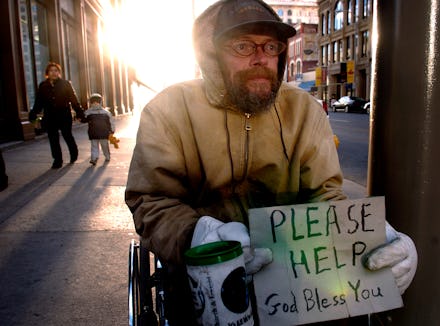Selfridges May Have Removed Its "Anti-Homeless Spikes," But It's Still a Problematic Trend

In early December, Selfridges, one of the United Kingdom's oldest and most high-end department stores, installed two rows of pointy metal spikes outside one of its Manchester locations.
According to a representative for the chain, the nasty steel accoutrements were put in place as a preventive measure. They were "part of a number of measures to reduce litter and smoking outside the store's team entrance, following customer complaints," the representative told the Independent.
This explanation didn't go over too well, because many saw the spikes as something else entirely: an "anti-homeless" device.
Similar mechanisms have popped up before. Last June, for example, a luxury apartment building in London ignited controversy when it installed rows of spikes outside its doors, and Tesco, a British supermarket chain, also received harsh criticism for the same tactic.
Selfridges decided to ignore this history of backlash and installed the spikes anyway, perhaps thinking that they could avoid detection. Unsurprisingly, they didn't — word soon got out and outrage burst forth anew. Demonstrations were planned outside the shop, and a Change.org petition to remove the spikes garnered almost 11,000 signatures. It described the spikes as "inhumane, ugly and nasty," arguing that they "symbolize everything that is wrong in attitudes to the most marginalized in society."
Selfridges eventually took notice. On Feb. 24, the Manchester Evening News reported that the department store was planning on removing the studs. "As a business, we value all feedback, and it was certainly never our intention to cause any offense," a spokesman told the paper.
While this is all well and good, it's still part of a worrying trend. Though Selfridges feigned innocence when it came to the purpose of the spikes, they did eventually cave to public pressure — as positive an outcome as could be expected.
But while three high-profile locations eventually removed the studs, the fact that they continue to pop up indicates a worrying trend.
"The spikes themselves are a relatively new phenomenon, but [they have] many predecessors," Eric Tars, the senior attorney for the National Law Center on Homelessness and Poverty, told Mic. "Things ranging from communities simply removing park benches, or installing park benches with railings in the middle so people can't lay down, and all of the criminalization laws that communities put in place to try and force homeless people out of public view and to go somewhere else."
In New York City, for instance, fire hydrants are equipped with medieval-looking spiky contraptions that prevent anyone using them to sit or rest, while downtown Nashville began removing benches for what the city said was an issue of safety, but what many advocates decried as an effort to deter the homeless from sleeping there.
The problem, Tars said, is that the spikes and measures like them do nothing to get at the underlying causes of homelessness. They simply allow society at large to go about its business and pretend like homelessness doesn't exist. When homeless people are forced away from public places, it makes it far easier to forget they're there at all.
"Essentially, it treats homeless people as problems to be dealt with through that kind of preventative measure as opposed to actually providing help," Tars said.
Things like studs also strip the homeless of their humanity — similar devices are, after all, also used to deter birds from nesting on roofs.
"It really is about who we are as human beings and what we are subjecting our fellow citizens to," Tars told Mic. "If we think of these people as human beings who are entitled to the same dignity that you or I would want to be treated with, then we would never subject somebody to those kinds of conditions."
We have plenty of proof that taking the opposite tack is more effective. In Utah, for example, the government began providing the homeless population with exactly what they needed most: a home.
"It's just so rational," Kerry Bate, the director of Salt Lake County's housing authority, told Mic in January. "We really should've figured it out a long time ago, but we had some mental blocks in the way." Since the program began in 2005, the rate of chronic homelessness has dropped by 74%, according to the New Yorker.
In New York City, a new pilot program is set to help pay the rent of victims of domestic violence who also have children — a subset of the population that constitutes 28% of homeless families living in shelters, the New York Times reported.
Rather than shuffling homeless people even further into the margins of society, programs like those in Utah and New York are shifting their focus. They're using sensible, compassionate approaches instead of doling out puritanical punishment for situations that can be nearly impossible to lift oneself out of.
Homelessness is a complex problem, and there are no magic bullets. But it's clear that methods like "anti-homeless" spikes and removing park benches do much more harm than good, and their continued existence only reinforces the fact that we need to work harder to stamp them out.
"Whether it's criminalization or other forms of penalizing homeless people or being on the streets, it's not only that it's not helping," Tars told Mic. "It's actually causing more harm."
h/t ThinkProgress